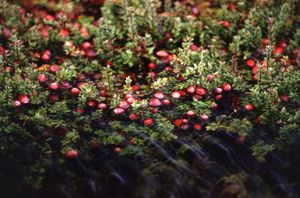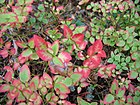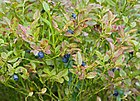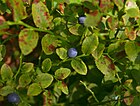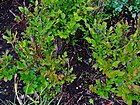Note: This is a project under development. The articles on this wiki are just being initiated and broadly incomplete. You can Help creating new pages.
Vaccinium - Karamarda
Cranberries are a group of evergreen dwarf shrubs or trailing vines in the subgenus Oxycoccus of the genus Vaccinium.
Uses
lowering blood pressure, diabetes, hemorrhoids, varicose veins, angina, cancers , kidney stones, Diarrhea, blood pressure
Parts Used
Chemical Composition
chrysoeriol, scopoletin, trans-p-hydroxycinnamic acid, trans-p-hydroxycinnamic acid ethyl ester, cafeic acid ethyl ester, beta-sitosterol, iuteolin, quercetin, esculetin , cafeic acid, isolariciresinol-9-O-beta-D-xyloside, 10-O-trans-p-coumaroylsandoside[1]
Common names
| Language | Common name |
|---|---|
| Kannada | Anduvan |
| Hindi | |
| Malayalam | Kelamaram |
| Tamil | Anduvan |
| Telugu | |
| Marathi | NA |
| Gujarathi | NA |
| Punjabi | NA |
| Kashmiri | NA |
| Sanskrit | |
| English | Indian Cranberry |
Properties
Reference: Dravya - Substance, Rasa - Taste, Guna - Qualities, Veerya - Potency, Vipaka - Post-digesion effect, Karma - Pharmacological activity, Prabhava - Therepeutics.
Dravya
Rasa
Tikta (Bitter), Kashaya (Astringent)
Guna
Laghu (Light), Ruksha (Dry), Tikshna (Sharp)
Veerya
Ushna (Hot)
Vipaka
Katu (Pungent)
Karma
Kapha, Vata
Prabhava
Habit
Identification
Leaf
| Kind | Shape | Feature |
|---|---|---|
| Simple | The leaves are ovate, in an irregular oval or slightly egg shape that is wider at the bottom than the top |
Flower
| Type | Size | Color and composition | Stamen | More information |
|---|---|---|---|---|
| Unisexual | 0.33" long | white to very light pink | 5-20 | Blooms are typically numerous and somewhat showy and Bloom time is May |
Fruit
| Type | Size | Mass | Appearance | Seeds | More information |
|---|---|---|---|---|---|
| blue-black berry | 0.25" to 0.5" diameter | eaten readily by wildlife and humans | ripen July through August | 1 | {{{6}}} |
Other features
List of Ayurvedic medicine in which the herb is used
- Vishatinduka Taila as root juice extract
Where to get the saplings
Mode of Propagation
How to plant/cultivate
Landscape Uses: Border, Massing, Seashore. Requires a moist but freely-draining lime free soil, preferring one that is rich in peat or a light loamy soil with added leaf-mould[3]
Commonly seen growing in areas
Photo Gallery
References
External Links
- Ayurvedic Herbs known to be helpful to treat lowering blood pressure
- Ayurvedic Herbs known to be helpful to treat diabetes
- Ayurvedic Herbs known to be helpful to treat hemorrhoids
- Ayurvedic Herbs known to be helpful to treat varicose veins
- Ayurvedic Herbs known to be helpful to treat angina
- Ayurvedic Herbs known to be helpful to treat cancers
- Ayurvedic Herbs known to be helpful to treat kidney stones
- Ayurvedic Herbs known to be helpful to treat Diarrhea
- Ayurvedic Herbs known to be helpful to treat blood pressure
- Herbs with Fruits used in medicine
- Herbs with Leaves used in medicine
- Herbs with common name in Kannada
- Herbs with common name in Malayalam
- Herbs with common name in Tamil
- Herbs with common name in English
- Habit - Deciduous Shrub
- Index of Plants which can be propagated by Seeds
- Herbs that are commonly seen in the region of Swamps
- Herbs that are commonly seen in the region of low wet woods
- Herbs that are commonly seen in the region of pine barrens and dry uplands
- Herbs
